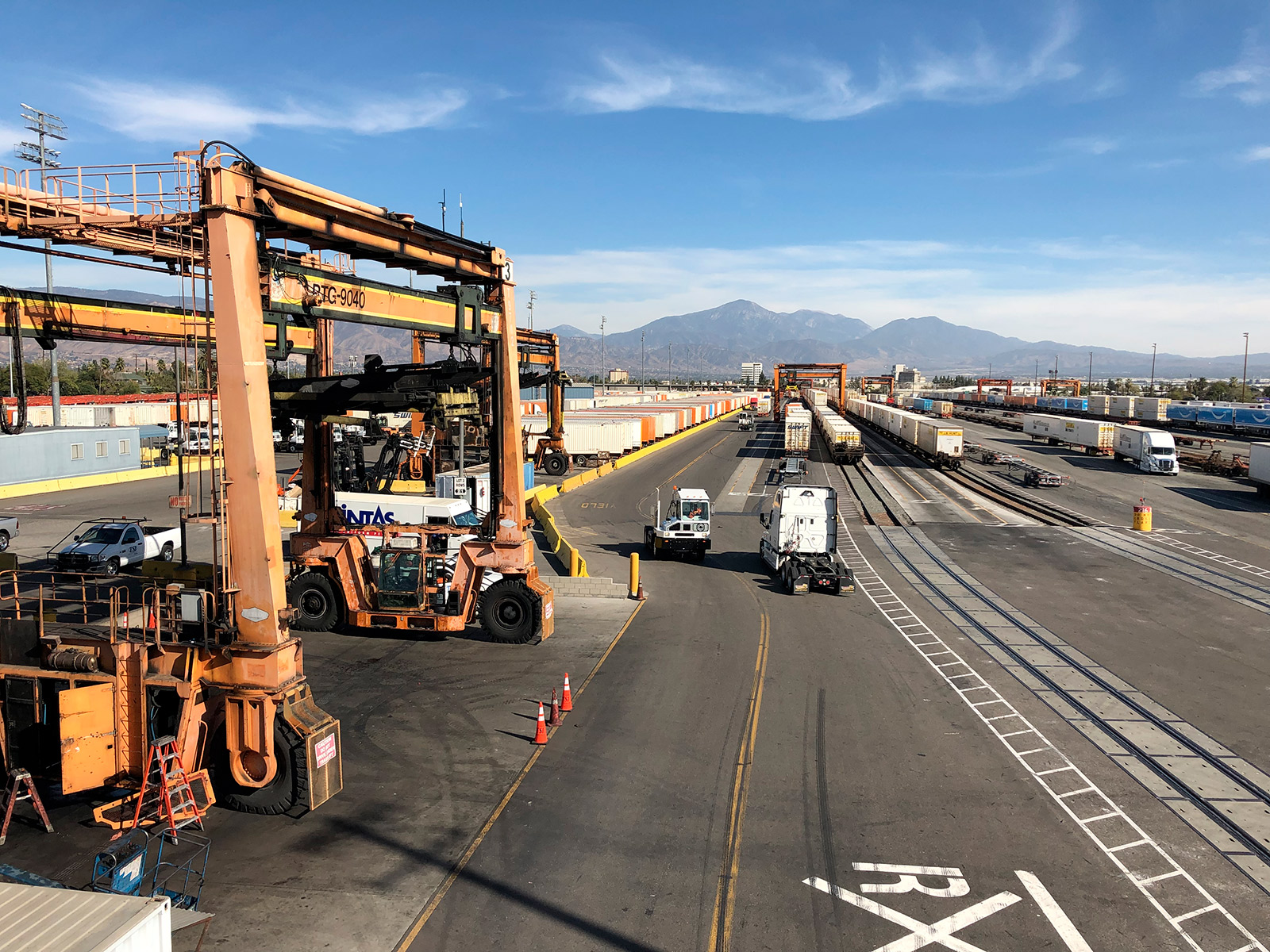Before the trucks came, Mira Loma Village was a quiet, 100-home neighborhood of modest ranchers in the city of Jurupa Valley. It was seen as a respite for those seeking open land, big sky, and a break from the constant whir of Los Angeles, just a 50-minute drive west. Miles of equestrian trails thread the city, and in some neighborhoods built specifically for keeping horses, those trails even take the place of sidewalks.
Starting in the 1990s, a 15-square-mile warehouse district was steadily built around the mostly low-income Hispanic community. Thousands of diesel delivery trucks followed. Now, enclosed by a tightening belt of traffic, Mira Loma residents live with ailments they’ve never had before, like chronic asthma, allergies, nosebleeds, and near-constant cold symptoms. Kids’ lungs aren’t developing like they should. Cancer is a constant worry.
Seeking environmental justice for their community, families in Mira Loma and throughout the city of Jurupa Valley, population 106,000, have spent decades advocating and mobilizing for change. That change finally came in October, when the Jurupa Valley city council approved plans to reroute diesel trucks out of Mira Loma and through Jurupa Valley’s industrial corridor instead. It’s not a permanent fix to the pollution that has plagued the community, but activists say it’s the first time families feel like their local government is listening to their concerns.
“It’s a huge step,” says Anthony Victoria, director of communications for the Center for Community Action and Environmental Justice (CCAEJ), which advocates on behalf of low-income communities of color in California’s Riverside and San Bernardino counties. CCAEJ, working with local families, was instrumental in spearheading the reroute. But, Victoria says, “This is just one step in a longer fight for environmental justice.”
Environmental Justice Communities
Decades of discriminatory policy decisions across the United States, from land use and zoning to mortgages and lending practices, have strategically deprived low-income communities of color of their economic, civil, and political rights, Victoria says. An unfathomable number of diesel trucks travel through Mira Loma and other environmental justice communities like it all day, every day. These are primarily low-income communities of color that have historically been excluded from policy decisions that directly impact their health and safety. As a result, refineries, freeways, superfund sites, and other major polluters are more often built around them.
Mira Loma and other communities adjacent to the ports of Los Angeles and Long Beach experience such high levels of air pollution that they’re known as “diesel death zones” or “asthma alleys” for the multitude of health issues residents face.
Diesel exhaust contains nearly four dozen toxic air contaminants, a class of pollutants so noxious that even low levels of exposure are linked to serious health issues and premature death. And air pollution doesn’t just affect a body’s lungs, heart, and metabolic systems. The microscopic particles that make up diesel exhaust can travel deep into the lungs, where they enter the bloodstream.
Once in the blood, pollutants can travel virtually anywhere in the body — including the brain — according to Ed Avol, a professor of clinical preventive medicine at the University of Southern California Keck School of Medicine. Although the relationship between air pollution and mental illness is less understood, a growing body of research has linked air pollution exposure to depression and other mental health issues, he says.
“You’re seeing pollutants interfere with the ability for children to learn or pay attention in class, which of course, can have lifelong effects,” says Avol, who has studied air pollution for nearly 40 years. “On the other end of life, we see it in older adults in the acceleration of loss of cognition, dementia, Alzheimer’s, and other mental issues.”
Residents of environmental justice communities like Mira Loma are more likely to experience pollution-related health issues than residents of most other neighborhoods. People of color across the U.S. are exposed to as much as 40 percent more nitrogen dioxide than white people, according to a 2014 study by the University of Minnesota. The pollutant, largely emitted from cars and power plants, is linked to ischemic heart disease, asthma, low birth weights, and stunted lung development in children.
In June of 2011, Riverside County officials approved construction of a 1-million-square-foot warehouse space. When the city of Jurupa Valley officially incorporated into Riverside County a month later, the community sprang into action against the proposed industrial center: CCAEJ, joined by then California Attorney General Kamala Harris, filed a lawsuit against the project.
County officials, according to the suit, neglected to study the environmental impact of the new warehouse space on Mira Loma residents, as required by the California Environmental Quality Act (CEQA). A settlement was reached in 2013, in which city officials and developers of the warehouse space agreed to mitigate its effects on the surrounding community of Mira Loma.
In addition to rerouting traffic, the settlement mandated routine air quality monitoring, planting trees and bushes to buffer air pollution in highly trafficked areas, and air filtration systems installed in every Mira Loma home. Harris described the settlement as a “model for local governments, developers, and communities to work together.”
The outcomes mark progress, but more work remains. “Air filters for every community member isn’t environmental justice — it’s mitigation,” Victoria says. “We’ll get to the problem with the restricted truck route, because it sets a mandate that these trucks aren’t impacting these communities.”
The Port Complex
Many of the trucks that drive through Mira Loma originate at the ports of Los Angeles and Long Beach. Combined, these ports form the San Pedro Bay Port Complex, the ninth-busiest port facility in the world. Spanning more than 10,000 acres along the California coastline, hundreds of billions of dollars’ worth of cargo move through the complex each year.
“A lot of what comes through the port communities doesn’t stay there,” Avol says. “The TVs and the clothing and everything else are being moved to Topeka, Omaha, New York, Chicago, Tampa, Houston.”
About 70 percent of the complex’s imports travel by rail or truck to warehouses and distribution centers like those in Mira Loma. Without the diesel trucks, many imports into the United States would never reach store shelves. “It can seem like whether an individual can breathe or not doesn’t seem to be as important as whether a truck delivers its goods,” Avol says.
In neighboring San Bernardino County, the logistics industry is also booming; there’s enough warehouse space owned by megabrands like Kohl’s, Mattel, and Pepsi to fill more than 5,000 football fields. This Inland Empire, as it’s called — a region of 4 million people that includes San Bernardino and Riverside Counties – also happens to be bounded by mountains. Any air pollution blown eastward from the ports is easily trapped there. It’s been an issue for decades.

BNSF rail yard in West San Bernardino. Justine Calma / Grist
“A child born in the South Coast air basin,” which includes parts of Los Angeles, Orange, Riverside, and San Bernardino counties, “has to live there only 12 days before he or she accumulates a lifetime acceptable cancer risk,” according to a 2002 report by the National Environmental Trust.
Such pollution was, and is, partly due to the aging fleet that still does much of the trucking from the ports. After the trucking industry was deregulated in the 1980s, drivers around the country found their positions reclassified as independent contractors, instead of full-time employees. “The ports were where old trucks would go to die,” says Jessica Durrum, director of the Los Angeles Alliance for a New Economy (LAANE)’s “Our People Our Port” campaign. “You had a lot of old diesel trucks there, because that was what the workers who had been forced to cover the costs of the trucks could afford.”
Many of these contractors have since needed to front the costs of maintenance and repairs on their trucks, too, rather than the trucking companies they work for. Even basic repairs can be too expensive for the drivers to afford, she says, let alone the types of equipment that can be installed to reduce emissions. Not only were many drivers forced into debt or predatory leases on their vehicles as a result of the deregulation, air pollution surged in the communities surrounding the ports.
“It had created not just a real environmental crisis, but an environmental justice and environmental racism crisis,” Durrum says, “because the community surrounding the ports in these freight corridors are largely low-income communities of color.”
LAANE has been campaigning for cleaner ports since 2006, when the advocacy organization joined forces with environmental justice groups, community partners, and labor unions around the country to form Southern California’s branch of the Coalition for Clean and Safe Ports. This work was on the heels of a 2002 lawsuit filed against the Port of Los Angeles by the Natural Resources Defense Council. After settling the suit in 2003, the port dedicated $50 million to mitigate air pollution in the surrounding community.
Facing this growing pressure to curb air pollution in these communities, the San Pedro Bay Ports Complex enacted the Clean Air Action Plan in 2006. One provision, called the Clean Trucks Program, has steadily phased out outdated diesel trucks from the ports, provided millions of dollars in incentives to trucking companies to replace their aging fleets, and will be investing in zero-emissions infrastructure in the years to come. Durrum says LAANE will continue to advocate for accountability in the trucking industry and for the rights of port truck drivers, especially independent contractors, so they won’t have to shoulder the costs of maintaining their trucks.
Starting in October 2008, the Clean Trucks Program prohibited all truck models built before 1989 from accessing the ports. By 2012, any trucks that didn’t meet the 2007 Federal Clean Truck Emissions Standards were also barred. In 2018, any new trucks servicing the ports were required to be 2014 models or newer.
As a result of the program, diesel particulate matter emissions at both ports have dropped 97 percent, nitrogen oxides (which form smog) have been reduced by 79 percent, and sulfur oxides (a component of acid rain) has fallen 91 percent, according to the Port of Long Beach. Both ports are now beginning to push for more near-zero or zero-emissions fleets and are considering offering rebates to drivers who update their trucks.
“Turning over an entire fleet of trucks certainly made an impact on air quality,” Durrum says, “It really did demonstrate the power of coalition-building, taking on a really ambitious challenge, and pushing forward a policy platform that was visionary in many ways and that aimed to be truly sustainable.”
Efforts like the Clean Trucks Program at the San Pedro Bay Ports Complex and truck reroutes out of neighborhoods like Mira Loma are avenues for environmental justice communities to start reclaiming their livelihoods.
“This community for a while, has felt very helpless,” Victoria says. “Being able to achieve a restricted truck route has given them a little glimmer of hope.”
Marguerite Casey Foundation nurtures a movement of low-income families advocating on their own behalf for change. The Foundation supports families strengthening their voice and mobilizing their communities to achieve a more just and equitable society for all.




